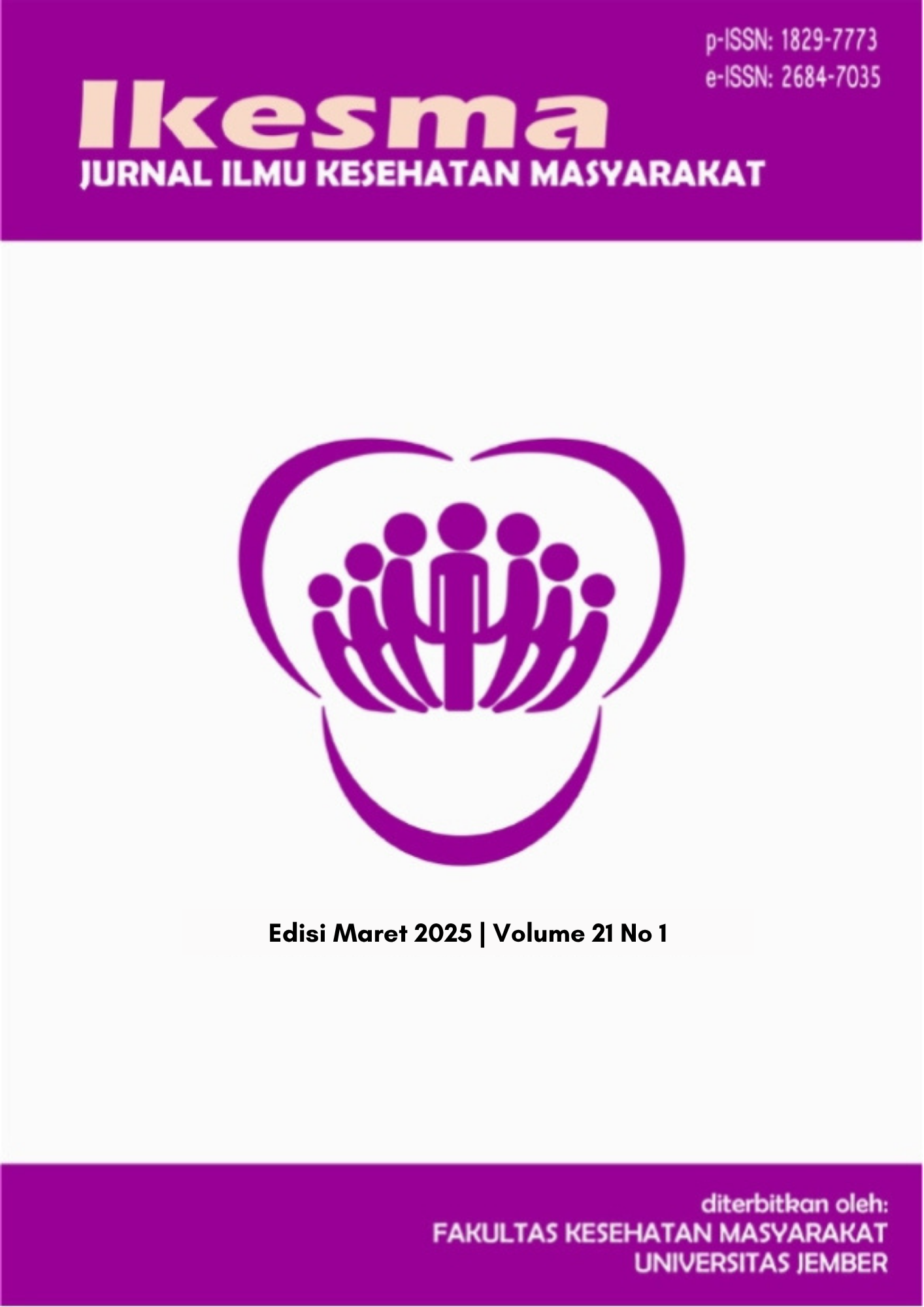RISK FACTORS OF CATARACT OCCURENCE AT THE SUMBERASIH PUBLIC HEALTH CENTER
DOI:
https://doi.org/10.19184/ikesma.v21i1.46955Keywords:
Cataract, Risk factors, Public Health CenterAbstract
Downloads
References
1] 2020) Pengaruh Diabetes, Hipertensi, Merokok dengan Kejadian Katarak di Balai Kesehatan Mata Makassar. JKesV 5(No. 1):45-52.
2] Hugosson M and Ekstrom C (2020) Prevalence anad Risk Factors for Age-related Cataract in Sweden. Upsala Journal of Medical Sciences 125(No. 4):311-315.
3] Jiang B, et al. (2023) Changing Trends in the Global Burden of Cataract Over the Past 30 Years: Retrospective Data Analysis of the Global Burden of Disease Study 2019. JMIR Public Health Surveill 9:e47349.
4] Karimi S, et al. (2023) Smoking and Environmental Tobacco Smoke Exposure: Implications in Ocular Disorders. Cutan Ocul Toxicol 42(1):1-7.
5] Kementerian Kesehatan RI (2017) Peta Jalan Penanggulangan Gangguan Penglihatan di Indonesia Tahun 2017-2030. Jakarta: Kementerian Kesehatan RI.
6] Mahendra IGBS and Andari MY (2022) The Effect of Exposure to Ultraviolet Rays of the Sun on Cataract Occurrence in Residents in Coastal Areas. Science Midwifery 10(No. 4):3219-3224.
7] Mrugacz M, et al. (2023) Current Approach to the Pathogenesis of Diabetic Cataracts. International Journal of Molecular Sciences 24(No. 7):6317.
8] Mylona I, et al. (2019) Hypertension is the Prominent Risk Factor in Cataract Patients. Medicina 55(No. 8):430.
9] Nuzzi R and Caselgrandi (2022) Sex Hormones and Their Effects on Ocular Disorders and Pathophysiology: Current Aspects and Our Experiences. Int J Mol Sci 23(No. 6):3269.
10] Sari AD, Masriadi and Arman (2018) Faktor Risiko Kejadian Katarak pada Pasien Usia 40-55 Tahun di Rumah Sakit Pertamina Balikpapan. Window of Health, 1(No. 2):61-67.
11] Sarkar D, et al. (2023) Age-related Cataract - Prevalence, Epidemiological Pattern and Emerging Risk Factors in a Cross-Sectional Study from Central India. Indian J Ophthalmol 71(No. 5):1905-1912.
12] Tan, et al. (2019) Evaluating the Associations between Obesity and Age-related Cataract: a Mendelian Randomization Study. The American Journal of Clinical Nutrition 110(No. 4):969-976.
13] Wati L, et al. (2023) Pencegahan Katarak dengan Penyuluhan Kesehatan dan Deteksi Dini Kejadian Katarak pada Nelayan Pesisir Daerah Kawal Pantai Bintan Kepulauan Riau. JAMSI 3(No. 4):1117-1124.
14] Wicitra RK, Zamzam M and Cahyani F (2023) Studi Deskriptif Gambaran Mengenai Kasus Katarak dan Refraksi di Provinsi Jawa Timur Tahun 2022. Jenggala 2(No. 1):37-48.
15] World Health Organization (2022) Eye Care in Health Systems: Guide for Action. Geneva: World Health Organization.
16] Xu X, et al. (2014) Hypertension and Risk of Cataract: A-Meta-Analysis. PLoS ONE 9(No. 12):1-17.
17] Zhang H, et al. (2022) Mendelian Randomization Study Reveals a Population-specific Putative Causal Effect of Type 2 Diabetes in Risk of Cataract. Int J Epidemiol 6(No. 50):2024-2037.
18] Zhang, et al. (2021) Body Mass Index is not Associated with Early Onset Cataract in the 45 and Up Cohort Study. ATM, 9(No. 22):1640.
Downloads
Published
Issue
Section
License
Copyright (c) 2025 Asri Ayu Firdausi, LATIFATU Choirunisa, Hengky Tri Cahyono Hasan, Mohammad Amarusmana

This work is licensed under a Creative Commons Attribution-ShareAlike 4.0 International License.






